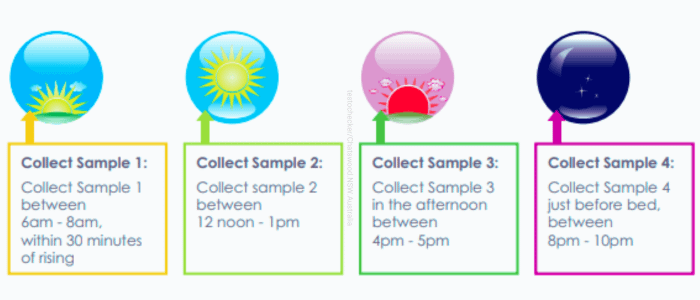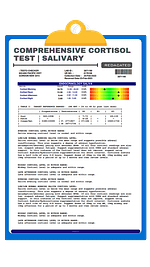In this post we address common questions about testing cortisol right here in Australia, and look at some of the options available when it comes to specimen type and test selection.
Cortisol is a hormone operating on a perpetual cycle known as the Circadian Rhythm. Other Circadian hormones, like progesterone, cycle on a monthly basis. Cortisol however, performs a complete cycle over 24 hours.
When not required, cortisol reverts to its inactive form, cortisone. Cortisol, a very powerful hormone, has the ability to disrupt or even block other hormones from performing their tasks. This can impact negatively in different ways, with the most obvious and frustrating being sleep disruption, and the most serious being the shortening of one’s life via mental & physical stress.

– Standard 4 point saliva cortisol collection schedule.
Cortisol testing – Specimen type?
Most cortisol testing is arranged by GP’s and hospitals utilizing traditional methods and there’s a good reason for this. While other specimen types like salivary cortisol exist, serum is often the preferred choice thanks to reliability and the established diagnostic thresholds (i.e. comparison charts) in place.
But here’s the thing! Cortisol, like other hormones, can be checked in different ways. And what many of us don’t realize is that the choice between specimen type has important implications. This is a little-understood but highly important aspect of cortisol testing, and for anyone considering testing their own cortisol, worth remembering.
Active Vs Inactive Cortisol _ What you should know

– Salivary cortisol results.
When we say ‘active’ cortisol, we mean cortisol moving around the body and having a real time impact. And in this instance, the term ‘inactive’ refers to cortisol bound to receptors, rendered dormant and not having any real impact. .
Saliva testing of cortisol provides us with the active hormone measurement only. Conversely, serum testing of cortisol provides us with a total (including inactive) hormone measurement only*.
Clarification: Approximately 95% of the total cortisol in our bodies is inactive and while it is possible to make a calculated estimate of FREE serum cortisol using formulae, a direct measurement is not achievable.
Serum & saliva are not the only established specimen types when it comes to cortisol testing. Much like saliva, urine and hair have long been proven to be reliable and accurate as a specimen (type) with a wide range of applications.
The D.U.T.C.H Dried Urine Hormone Profile by Precision Analytica™
The most recognized Urine hormone test is the D.U.T.C.H™ Dried Urine Hormone Profile. Both the ‘Advanced‘, & ‘Complete‘ versions of the D.U.T.C.H™ test are well renowned, and provide enormous value in spite of their considerable cost. The good news is that for those of us simply wanting to rule out an obvious cortisol irregularity, there are more affordable saliva cortisol test kits.
Multi-point specimen collection favours saliva
To gauge the wellbeing of the hormone we need to observe its behaviour and this requires the collection of multiple samples over a day or longer. Multi-point testing is the solution due to both the convenience, and accuracy (see further down this page). Let’s take a quick look at the three most commonly used saliva cortisol tests so we can make an informed choice when the time comes.
And with specimen collections at multiple time points, saliva makes a good choice when assessing adreno-cortex health.

– Saliva cortisol testing.
Cortisol test kit configurations
We have the choice to check the morning behaviour of cortisol (CAR) involving three specimen collections. Or, using a bigger test, between 4 and 6 specimens are collected to capture the 24hr Cycle (Comprehensive). DHEA’s levels are sometimes checked alongside cortisol due to the relationship between the two. Low cortisol production may be due to low DHEAs, however this is not common, and testing both isn’t essential.
Each of the three cortisol tests highlighted below provide a wide view observation of the hormone behaviour. Test results include a summary by the testing lab, and advice is included in cases where an irregular result is revealed.
Established Cortisol Tests available in most Big Labs
Comprehensive Cortisol Test Kit The larger ‘24 hour Comprehensive Cortisol Test’ records the Cortisol Daily Pattern in full. In addition to checking morning cortisol values, this test will also reveal the hormone evening / night behaviour. This is important, as the cortisol output should be almost non-existent by nightfall.
Cortisol Awakening Response (CAR) Test Kit The ‘Cortisol Awakening Response test [CAR]’ includes 3 saliva collections in the morning and records the expected rise and fall in cortisol values. This is also important as we require that burst of cortisol to give us the boost we need for the day ahead. However, the cortisol produced should also disperse by midday and test result charts will highlight if this is in fact occurring. The morning cortisol behaviour is recorded and charted using the CAR test kit.

– Cortisol should peak after waking.
Adrenal Function Extended Profile Test Kit (AKA Adrenocortext Profile) This well established four point saliva test also measures the cortisol daily pattern but includes DHEAs which is tested from the first collection only. Low DHEAs often indicate cortisol irregularity and are a vital clue when assessing adrenal function. The results from the ‘Adrenal Function XP test’ will reveal just how much stress your body is under.
How long does it take to test Cortisol using Saliva?
At-home cortisol test turn-around-time is six to 8 working days. Should irregular cortisol levels be discovered, re-testing to confirm the result will take place adding two more days to wait time.
Is Saliva OK for testing Cortisol?
Far more than merely OK, saliva is now the preferred method for cortisol analysis[l]. One reason is that many of the hormones that regulate our physiology, including reproductive function or the ability to control stress, are cycling. Because of this, testing cortisol comprehensively includes multiple samples collected at all hours, and using serum for the purpose would present an array of challenges.
Saliva contains various biomarkers such as DNA, RNA, antibodies, and hormones which means that it can provide highly relevant diagnostic information. Like all sample types saliva does however have its limitations. Only a handful of the approximately 50 hormones lurking beneath our skin are able to be analysed this way. Another limitation is the potential for contamination of the specimen via blood.
Verdict – There is no perfect specimen type in pathology and it is a good idea to get advice from a trusted source if you’re new to saliva cortisol testing, or considering doing it online for the first time.
Hand written by Guy,
Brought to you by: TestoChecker™
Ground Floor, /465 Victoria Ave, Chatswood, NSW, 2067
Sources cited: [l] Salivary cortisol measurement– a reliable method for the diagnosis of Cushing’s syndrome [PMID: 15891959]
Disclaimer: TestoChecker™ believes in the importance of a healthy hormone balance. They’ve been providing Test Kits for checking hormones for years utilizing a variety of specimen types including saliva, hair, urine and others you don’t want to read about.Additional reading:
What’s So Important About the Stress Hormone Cortisol? • FAQ – saliva hormone testing in Australia • How to order a hormone test at TestoChecker?
Guest Checkout enabled.
GeoTrust™ Business EV SSL/TLS Certificate is currently installed on this website.
